Text
Nadja - Day 34
Race: Fairy
Alignment: Neutral
May 8th, 2024

Oftentimes, a person can have an obsession. The luster of gold, the smell of sweet pastries, or even the simple idea of snow. However, sometimes, that obsession isn't over materialism or a connection to humanity- it can be a love so corruptible and depraved it drives any and all to madness. This is the focus of the surrealist piece of French literature Nadja, a book named after the beginning of the Russian word for hope, "though only the beginning." "Who am I?" the story asks in its first line, a representation of things to come in a spiraling journey into a 10-day obsession with a woman the main character barely seems to know- a woman he's so transfixed by it's almost like a spell.
Nadja is one of the most iconic pieces of surrealist literature out there, serving as a story in three parts. Unfortunately, given that I make these daily, I can't really give it the time of day it likely deserves, so you'll have to do with the cliff notes summary. In general, the story begins with ruminations on the self and surrealist principals from the main character André before switching to a far more linear format for its next few parts, turning into a tale about a brief fling the man had with the eponymous Nadja, a woman who he cared less for her appearance and more for her worldview, one vast and fascinating.
As this trust goes on, however, André finds himself distanced from Nadja as the mystique of her worldview begins to fade away- his questions are answered, her mind becomes less of an enigma, and he ultimately asks- did he love her for who she was, or just for the experience of understanding the unknown? As their romance comes to a close, the book takes a structure of ruminations and reminiscing, and the brief reality he was exposed to becomes a clear part of his worldview- that of surrealism, and how sometimes, the lack of understanding of the world is more impactful than an eclectic knowhow of how other people work.
The demon in question, Nadja, is a manifestation of both the eponymous Nadja herself, as well as the themes of surrealism present throughout the book. Her appearance is almost childlike, showing an innocence towards the world, or a lack of understanding of others and their thoughts. The necklace of bones is also just a neat design choice. Overall, Nadja is a fascinating book to look into packed chock-full of symbolism and surrealism, and the demon in SMT deserves to be one, given her connections to the root of the surrealist movement itself.
8 notes
·
View notes
Note
I’m feeling in a Devil Survivor mood today, care for me to ask for Jezebel?
Jezebel - Day 33 (Request)
Race: Bel
Alignment: Free Palestine! 🇵🇸
May 7th, 2024
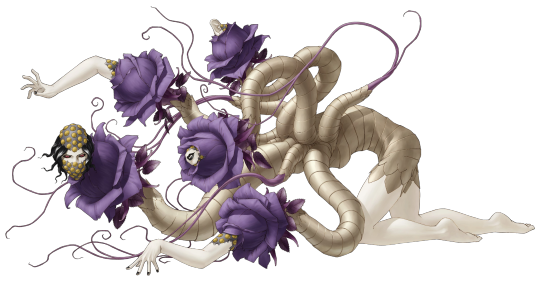
Abrahamic faith and SMT go hand-in-hand. There's a reason YHVH is such a recurring figure in the series, and it's not just due to ATLUS wanting to see god be dethroned every entry. Hell, in mainline, a good amount of theming is based around abrahamic religions, such as things like the Law-Chaos dichotomy or literal Lucifer being a major character in almost every game in the series. However, if there's one game in the series famous for its Christian roots, it'd have to be the first Devil Survivor. Whether it be the main character literally being Abel, the demonic invasion having heavy ties to a biblical apocalypse, or many other characters in the story being reincarnations of biblical characters, Devil Survivor is rife with Christian themes. Admittedly, I haven't played it yet, being a mainline and DDS fan first and foremost, but its themes being so explicitly connected to abrahamic faith to the point it makes even mainline blush is notable to me.
Now, what does this have to do with anything? It has to do with our demon of the day! Great segway, I know. Today's demon of the day is the wicked witch and promoter of Baal, Jezebel! Being an infamous figure for good reason, Jezebel was responsible for many things associated with false prophets- whether it be propping up fake gods like Baal and Asherah or slaughtering Yahwist priests, she was responsible for the fall into heresy that the Omride dynasty experienced. In spite of how unpopular the dynasty grew to be to the common israelite who lived under her, Jezebel promoted growth, eventually leading to conflict with her own people. Only being a princess, she could only promote worship of Baal, however she often went out of her way to kill people who worshipped capital-g God, leading to Panic! At Jerusalem.
Eventually, she led to the death of Naboth in an act of greed for a fellow Israeli citizen, executing the man for not wishing to share his prosperous vineyard with her husband, Ahab. Watching this flagrant disregard for his people, though, was God, who was utterly fuming. Seeing the fall into heresy that Jezebel led Israel right into, he gave Elijah a prophecy- one of the eventual death of Jezebel. The man would report that prophecy to King Jehu, who would give a solid order- one to execute the woman. Jezebel then proceeded to be thrown through a window and eaten by dogs. Yes, really. Death by defenestration is a biblical thing.
Ever since that story, Jezebel has become synonymous with false prophets and heresy in abrahamic faiths, with her name typically being referred to as shorthand for any who manipulate others through lies and gaslighting. As unpopular as she was until her death, though, she's still referred to by many in that same context, and you may find people referring to others as 'Lustful Jezebels' if they're lame enough. Her name was also attached, in the Book of Revelations, to a priest who began to spread sexual promiscuity to her people, hence the "lustful" part of that saying.
Now, in SMT, her design is utterly fascinating- appearing as a late-game boss fight in Devil Survivor, the flowers seem to symbolize promiscuity, while the many tendrils emerging from the torso seem to represent all manners of manipulation. Her design is packed with layers of metaphor, and the imagery of flowers can also represent both 'honeyed words,' as well as the spreading of lies, like pollen. Her design also is frankly sick looking- I really gotta play Devil Survivor, huh? Overall, Jezebel is a fantastically designed demon with some serious importance behind her, a representation of sin and manipulation that I adore.
#shin megami tensei#smt#megaten#persona#daily#ask#btw for the record#fuck israel#this is a purely historical spotlight#and i will NOT tolerate any zionism in the notes#okay? okay.
4 notes
·
View notes
Note
Ongyo-ki?
Ongyo-Ki - Day 32 (Request)
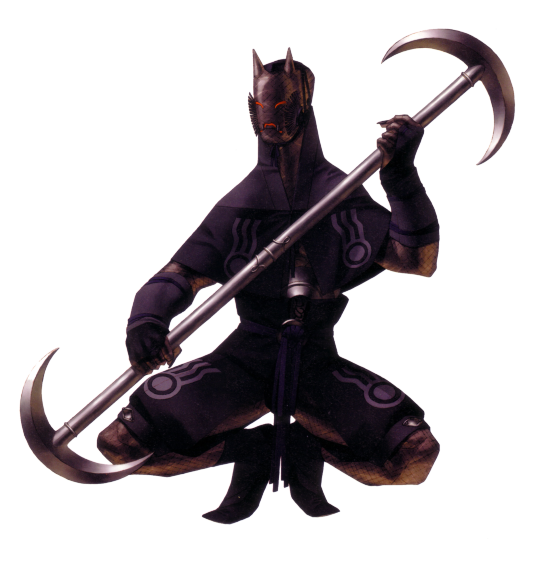
I haven't used this oni since the Heian era! Today's demon of the day is a demon Nocturne players know well (for being incredibly annoying,) the shadow-striking demon and purported origin of Ninjutsu, Ongyo-Ki!
In Japanese mythology, Oni are prevalent; they're commonly depicted as shapeshifting brutes who will happily pillage villages and eat anything that gets in their way. However, they are still sapient, and are possible to commune with, given enough time and diligence, and can even be controlled by one with a strong enough will. Introducing the retainer of the four oni of infamous myth, Fujiwara no Chikata. Unfortunately, I am terrible at Japanese, and there is almost nothing about him in English!
Based on my very limited knowledge, mostly pulled from @na-vidya-na-avidya 's fantastic breakdown of this case, Fujiwara no Chikata was a sorcerer during the Heian (or, confusingly, sometimes the pre-Nara) period who had control over and communed with four Oni, each having control over different powers (and each showing up in SMT! Who knew?) which went as follows: Ongyo-Ki, Sui-Ki, Kin-Ki, and Fuu-Ki, each of which had control over their own domains through manipulation of their auras. The specific Oni requested, however, Ongyo-Ki, has an ability purported to be the origin of the typical depictions of Ninjas and their stealth-based sorcery.
Ongyo-Ki, specifically, has control over his own aura in the way that he can completely suppress it, disappearing into the shadows. Using this ability, he disappears completely from sight and any form of detection, able to strike from the darkness at any time by hiding away. This translates into his infamous boss fight in SMT Nocturne, with the oni's mastery over shadows translating into a control over the domain of illusions.
Sorry for the short spotlight, there just isn't much to go off of with this demon! If you're interested in further research into Fujiwara, check out this post. Thank you for reading!
7 notes
·
View notes
Text
No upload today, sorry :(
We're kinda low on food rn and it's making it really hard to get the motivation to do much of anything, so imma have to take the day off.
8 notes
·
View notes
Note
Can i request Tarrasque, please.
Tarrasque - Day 31 (Request)
Race: Drake
Alignment: Dark-Chaos
May 2nd, 2024

An entire month?! Jesus H, I'm surprised I've kept this up for so long. Thank you all for tagging along with this silly project of mine as long as you have! Celebrations aside, though, today's demon is a relatively obscure one, appearing mostly just in the earlier games in the series: The great French Dragon, the Tarrasque. Now, most know this monster from the trenches of 5e, wherein it serves commonly as a BBEG of many a campaign, as well as apparently in MTG? I know next to nothing about Magic, so I'll just take Google's word for it. However, in spite of how much it seems tailor-made to simply be a giant boss monster in some random DnD or Pathfinder campaign, this massive beast actually originates from a french fairytale about a badass Christian saint lady who was friends with Jesus Christ. No, I am not joking.
Backing up a smidge, the Tarrasque in the story first appears as a massive dragon ravaging the French city of Tarascon (no doubt where it got its name, though it's vague- either the Tarrasque got its name from Tarascon, or, more popularly, Tarascon got its name from the Tarrasque), though its appearance is anything but- as described in the tale,
"It was fatter than an ox, longer than a horse, with a lion’s face and head, teeth as sharp as swords, a horse’s mane, its back as sharp as an axe, bristling and piercing scales, six feet with bear’s claws, a serpent’s tail, and a shell on either side like a tortoise." The story also describes it as being downright massive, 15 meters tall and 20 meters long.
The story paints a picture of it being more than just a simple animal, though, as past its chimerical appearance, it was also apparently the offspring of the biblical leviathan. Saint Martha, a young woman who traveled to the town with the intent of evangelizing it, eventually was stopped and asked for help in defeating the beast- each time they would try, it would simply deflect each attack without a care in the world before retreating back underwater, only to return the next day to continue wreaking havoc. Martha, being the sister of Mary Magdalene, was deeply religious and connected to the big man upstairs, and thusly she approached the monster with naught but her faith.
Surprisingly, it worked. The Tarrasque fell tame soon after being splashed with holy water and having a cross waved in its face, and Martha grew to become a patron saint of the village. While this heavily Christian tale is the only recollection of the Tarrasque we're aware of, there is still quite a bit to dig into- as some scholars hypothesize, the Tarrasque serves as a metaphor for sin and evil, representing how such things can destroy a community and how, who else, but our man Jeezy-C can help bring back a community from destruction. Overall, while a short and simple tale, the story of the Tarrasque gives way to a surprisingly unique monster, this kaiju-esque hybrid.
Now, in terms of SMT, the design is surprisingly faithful to its original depiction, what with the lion head, turtle shell, six legs, and overall just how weird it is. I've yet to play the Raidou games nor SMT II, so I can't give much of a rundown on how it works in-game, but all-in-all, the Tarrasque is a demon worthy of the spotlight. Thanks for the request!
15 notes
·
View notes
Note
oh yeag here are my sources (i keep forgetting to cite them)
https://provence-alpes-cotedazur.com/en/things-to-do/culture-and-heritage/traditions/tarasque/
https://web.archive.org/web/20100330232134/http://www.catholic-forum.com/saints/golden239.htm
https://folklore-society.com/resources/tarasque/
Can i request Tarrasque, please.
Tarrasque - Day 31 (Request)
Race: Drake
Alignment: Dark-Chaos
May 2nd, 2024

An entire month?! Jesus H, I'm surprised I've kept this up for so long. Thank you all for tagging along with this silly project of mine as long as you have! Celebrations aside, though, today's demon is a relatively obscure one, appearing mostly just in the earlier games in the series: The great French Dragon, the Tarrasque. Now, most know this monster from the trenches of 5e, wherein it serves commonly as a BBEG of many a campaign, as well as apparently in MTG? I know next to nothing about Magic, so I'll just take Google's word for it. However, in spite of how much it seems tailor-made to simply be a giant boss monster in some random DnD or Pathfinder campaign, this massive beast actually originates from a french fairytale about a badass Christian saint lady who was friends with Jesus Christ. No, I am not joking.
Backing up a smidge, the Tarrasque in the story first appears as a massive dragon ravaging the French city of Tarascon (no doubt where it got its name, though it's vague- either the Tarrasque got its name from Tarascon, or, more popularly, Tarascon got its name from the Tarrasque), though its appearance is anything but- as described in the tale,
"It was fatter than an ox, longer than a horse, with a lion’s face and head, teeth as sharp as swords, a horse’s mane, its back as sharp as an axe, bristling and piercing scales, six feet with bear’s claws, a serpent’s tail, and a shell on either side like a tortoise." The story also describes it as being downright massive, 15 meters tall and 20 meters long.
The story paints a picture of it being more than just a simple animal, though, as past its chimerical appearance, it was also apparently the offspring of the biblical leviathan. Saint Martha, a young woman who traveled to the town with the intent of evangelizing it, eventually was stopped and asked for help in defeating the beast- each time they would try, it would simply deflect each attack without a care in the world before retreating back underwater, only to return the next day to continue wreaking havoc. Martha, being the sister of Mary Magdalene, was deeply religious and connected to the big man upstairs, and thusly she approached the monster with naught but her faith.
Surprisingly, it worked. The Tarrasque fell tame soon after being splashed with holy water and having a cross waved in its face, and Martha grew to become a patron saint of the village. While this heavily Christian tale is the only recollection of the Tarrasque we're aware of, there is still quite a bit to dig into- as some scholars hypothesize, the Tarrasque serves as a metaphor for sin and evil, representing how such things can destroy a community and how, who else, but our man Jeezy-C can help bring back a community from destruction. Overall, while a short and simple tale, the story of the Tarrasque gives way to a surprisingly unique monster, this kaiju-esque hybrid.
Now, in terms of SMT, the design is surprisingly faithful to its original depiction, what with the lion head, turtle shell, six legs, and overall just how weird it is. I've yet to play the Raidou games nor SMT II, so I can't give much of a rundown on how it works in-game, but all-in-all, the Tarrasque is a demon worthy of the spotlight. Thanks for the request!
15 notes
·
View notes
Note
Can i request Tarrasque, please.
Tarrasque - Day 31 (Request)
Race: Drake
Alignment: Dark-Chaos
May 2nd, 2024

An entire month?! Jesus H, I'm surprised I've kept this up for so long. Thank you all for tagging along with this silly project of mine as long as you have! Celebrations aside, though, today's demon is a relatively obscure one, appearing mostly just in the earlier games in the series: The great French Dragon, the Tarrasque. Now, most know this monster from the trenches of 5e, wherein it serves commonly as a BBEG of many a campaign, as well as apparently in MTG? I know next to nothing about Magic, so I'll just take Google's word for it. However, in spite of how much it seems tailor-made to simply be a giant boss monster in some random DnD or Pathfinder campaign, this massive beast actually originates from a french fairytale about a badass Christian saint lady who was friends with Jesus Christ. No, I am not joking.
Backing up a smidge, the Tarrasque in the story first appears as a massive dragon ravaging the French city of Tarascon (no doubt where it got its name, though it's vague- either the Tarrasque got its name from Tarascon, or, more popularly, Tarascon got its name from the Tarrasque), though its appearance is anything but- as described in the tale,
"It was fatter than an ox, longer than a horse, with a lion’s face and head, teeth as sharp as swords, a horse’s mane, its back as sharp as an axe, bristling and piercing scales, six feet with bear’s claws, a serpent’s tail, and a shell on either side like a tortoise." The story also describes it as being downright massive, 15 meters tall and 20 meters long.
The story paints a picture of it being more than just a simple animal, though, as past its chimerical appearance, it was also apparently the offspring of the biblical leviathan. Saint Martha, a young woman who traveled to the town with the intent of evangelizing it, eventually was stopped and asked for help in defeating the beast- each time they would try, it would simply deflect each attack without a care in the world before retreating back underwater, only to return the next day to continue wreaking havoc. Martha, being the sister of Mary Magdalene, was deeply religious and connected to the big man upstairs, and thusly she approached the monster with naught but her faith.
Surprisingly, it worked. The Tarrasque fell tame soon after being splashed with holy water and having a cross waved in its face, and Martha grew to become a patron saint of the village. While this heavily Christian tale is the only recollection of the Tarrasque we're aware of, there is still quite a bit to dig into- as some scholars hypothesize, the Tarrasque serves as a metaphor for sin and evil, representing how such things can destroy a community and how, who else, but our man Jeezy-C can help bring back a community from destruction. Overall, while a short and simple tale, the story of the Tarrasque gives way to a surprisingly unique monster, this kaiju-esque hybrid.
Now, in terms of SMT, the design is surprisingly faithful to its original depiction, what with the lion head, turtle shell, six legs, and overall just how weird it is. I've yet to play the Raidou games nor SMT II, so I can't give much of a rundown on how it works in-game, but all-in-all, the Tarrasque is a demon worthy of the spotlight. Thanks for the request!
15 notes
·
View notes
Text
Wendigo - Day 30
Race: Jaki
Alignment: Dark-Law
May 1st, 2024
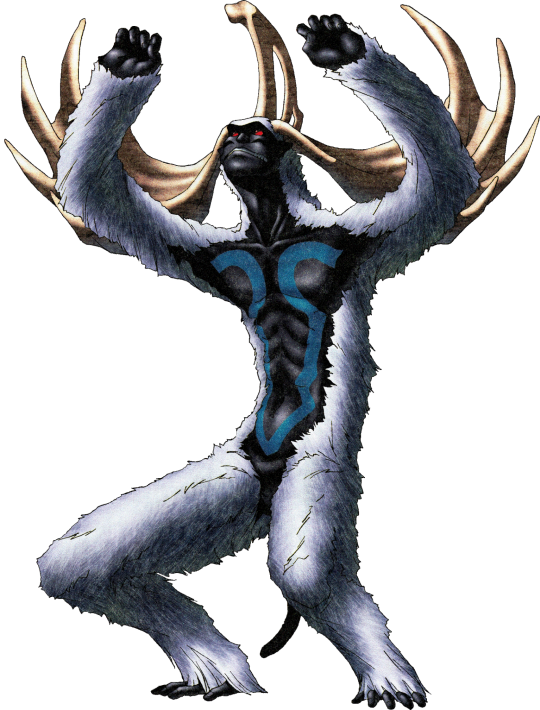
Full disclosure; Wendigos are a very, very touchy subject. As a being that is inherently connected to Algonquian mythology, and one that has a lot of misconceptions surrounding it, I'm just going to profess that, as a person who is whiter than white, if anyone who is Algonquian wants to correct any factoids here, I would happily accept it. The last thing I want to do is misrepresent anyone's culture or disrespect it. I know this may sound a bit hypocritical, but I just wanted to make my intentions clear.
Anyway, with that out of the way, today's demon of the day is the Canadian flesh-eating witch, the Windigo! Also spelled as Wendigo, these evil spirits exist almost as a cautionary tale, of sorts, warning against the dangers of greed and hunger in Algonquian tradition.
Appearing most-often in stories told within groups of people such as the Ojibwe and the Cree, these monsters are flesh-eating spirits who reside in the mountains and trees of wintertime Canada, their appearances gaunt and smelling of death. Strongly associated with famine, the north, the cold, and starvation, these giant beasts were most famous for their propensity for slaughtering people, though their hunger would never be satiated, no matter how many men, women, and children they would eat. As told in quite a bit of folklore, the Windigo would grow in proportion to whatever it had just devoured, thus never letting it be full, always starving yet still representing the excess of gluttony. These beasts were also capable of human speech in many traditions, commonly taunting their victims or toying with people who dared to investigate them.
My personal favorite story surrounding the Windigo has to do with the idea of them being humans-turned, people corrupted by greed and hunger who cut off their own humanity and cooperation with their fellow man, forms twisting into these great, gaunt beasts. Windigo are utterly terrifying in many ways, their hunger never satiated and always looking for their next meal. They work as a potent metaphor for greed and starvation, though unfortunately, this has led to quite a bit of co-opting from other people groups who view them less as an inherently Algonquian myth, and more as a 'cool, spooky monster.' A shame, honestly.
Now, what do I mean by inherently Algonquian? It's simple- not only are these tribes still around, but Windigo, from my knowledge, are connected intrinsically with the struggles of those peoples. Things like famine, the fear of the cold, and the terror of starvation, they all tie back into the aggrandizing greed that the Windigo represents. As Brady DeSanti, an Ojibwe scholar, put it, "[The Wendigo] can be understood as a marker indicating... a person... imbalanced both internally and toward the larger community of human and spiritual beings around them." The Windigo, as well, is seen as representing the consumption of not only people, but entire cultures as well- in a way, it could be seen as a metaphor for colonialism, tying it back to the ever-present issues that Native Americans have always faced. Wendigo are the embodiment of manifest destiny, the ever-present greed and hunger for more leading to heedless destruction under the belief that what they found was this.
All of this goes to say, Wendigo are a very hard topic to parse, made of several connecting pieces- folklore, colonialism, greed, hunger, betrayal, corruption, all of these combine together to make the terrifying face of this Algonquian monster. As such, it is very, very hard to talk about sufficiently, especially for my proclivities. However, how about its portrayal in SMT? In opposition to the typical pop-cultural depiction of the Wendigo, its design in the series is incredibly unique. The white fur gives way to an idea of a stereotypical yeti, the black skin is gaunt and worn, and the blue patterns give it a strange feeling of being wrong, in some way. The headdress adorning its head has the appearance of antlers, connecting this otherwise otherworldly design to its more contemporary counterparts, but otherwise its design is unique and honestly really interesting. It definitely feels like its own thing, disconnected from most pop-culture definitions. In gameplay, the Wendigo... evolves from Jack Frost, for some reason? But it serves as a physical attacker with an ice specialty when it comes to magic, making it a decent early-mid game demon.
Overall, with its interesting folklore, unique design, and prowess in gameplay, Wendigo is a very interesting demon.
6 notes
·
View notes
Text
I uploaded day 29 early on accident 😭 sorry lmao, guess I get a break tomorrow at least in exchange for a double feature.
1 note
·
View note
Note
May I ask for Dagda please?
Dagda - Day 29 (Request)
Race: Deity
Alignment: Neutral
April 29th, 2024
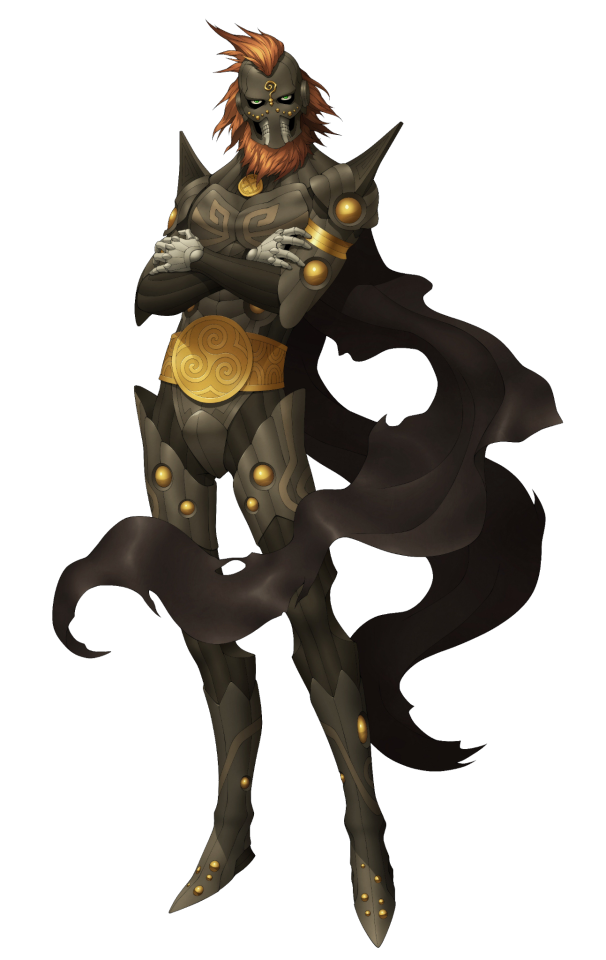
Ah, Celtic mythology. What would SMT do without you? Today's demon of the day, by request of @kitkatisacat, is the supreme leader of the Tuatha Dé Danann, the Dagda! With a special spotlight in SMT IV: Apocalypse, this druidic deity has many a myth attached to him, being one of the greatest heroes that Irish myth has.
The origins of Dagda are unclear, but the mythos purports that every one of the Tuatha Dé Danann, the mysterious and inherently mystical race that Dagda, among many others, belong to, originate and live within the mysterious 'Otherworld.' Descriptions of the otherworld are vague and varied, but are typically described as a "heavenly land beyond the sea, or under the earth's surface," as Celticist John Carey put it. This could basically mean any island far from Ireland, and this is when a major road bump presents itself: Much like Norse mythology, basically all primary sources on Irish mythology are heavily bastardized by Christian influence. The Tuatha Dé Danann could be gods, as commonly theorized, but are always portrayed as another race, one of witches, scholars, or fallen angels. This makes research frustrating, to say the least, as it's hard to distinguish between a genuine account and some Christian fanfiction tossed into the Celtic melting pot.
However, given that Tuatha Dé translates almost directly to "Tribe of the gods," we can make some extrapolations. Even the term Tuatha Dé Danann translates to "Folk of the goddess Danu," who likely is in the same boat as the norse "god above all other gods," given her lack of references in other texts- aka, another Christian retcon! Isn't mythology fun? Now, with that out of the way, Dagda originates as a deity who arrived at Ireland from overseas, and was one of the great leaders of the gods, seeming to be the head of the pantheon in a way. He possessed many mystical artifacts, including an always-full cauldron of porridge, fruit trees that were always ripe, two immortal pigs, and a massive club that could both kill and give life. His harp, another possession of his, played itself, and could bring about the seasons. All of this is to say, Dagda wasn't just a mystical man, but easily could be extrapolated into being the head god of sorts in the Irish pantheon, that was then retconned into just being mystical people from a far-off land.
The Dagda, though, had a sour attitude unbefitting of his heavenly role- most depictions of him are of a foul-mouthed man in a peasant's tunic, one who cares little for what others say, but ultimately is benevolent. Unfortunately, depictions of him are very scarce, as he was typically thought of as one of those gods, the omnipresent ones who embody everything under their domain. This does tie into what is a rather popular tale, though- the one about the war with the Fomorians.

I'll cover them more in-depth in their own spotlight later down the road, but the Fomorians were essentially demonic pirates from overseas who went to plunder and destroy for their own gain. Seeing their approach, the Tuatha Dé Danaan prepared for conflict, but Dagda struck out on his own. Having seized the land targeted years ago from the Fir Bolg, he was unwilling to concede, but also wanted to avoid needless violence and thus approached the Fomorians with a peace treaty. Predictably, they refuse, and challenge him to drink the endless cauldron of porridge he carries in order to get home safe. Likely thinking they had him, they only watch as the Dagda proceeds to bottoms-up the entire cauldron, dunking the entirety of the porridge down his throat and even licking the bottom to clean up any sticking scraps.
Baffled, the Fomorians gave up, let him go home, and prepared for battle. It would be during this battle, however, taking place a few days later, that unfortunately, the Dagda would lose his life at the hands of Caitlín, the wife of Balor, leader of the Fomorians. Unfortunately, a lot of this is frustratingly vague, holes upon holes of understanding left behind due to the fractured history surrounding Celtic myth. There are several retellings of several myths- in some of them, Dagda doesn't die, or he dies from his wounds, or even escapes into an underground palace. All of this goes to say, we can thank historical Christians for messing everything up.
Past all this, though, Dagda has a fantastic design taking heavy inspiration from what little we can glean about him, and his role in Apocalypse cannot go understated. All of this goes to say, while this was a difficult DDS, the Dagda's role in it is fascinating.
#shin megami tensei#smt#megaten#persona#daily#ask#request#I ACCIDENTALLY UPLOADED THIS ONE EARLY#FUCK ME#oh well ig tomorrow i get a break lmao
15 notes
·
View notes
Text
Chemtrail - Day 28
Race: Fiend
Alignment: Neutral
April 29th, 2024

Most demons throughout the SMT series are mythological beings, cryptids, historical figures, or just plain demons, but sometimes, they like to experiment. Sometimes, they make demons like the subject of today's Demon Spotlight, Chemtrail- a demon not based upon a historical account nor a religious belief, but rather, based on a conspiracy theory.
The idea of chemtrails originates in 1996, particularly from a report published by the US army regarding the idea of weather modification being used in warfare- as the conspiracy goes, the trails of condensation left behind by jets, known as contrails, are actually lines of chemical agents sprayed all over the public for nefarious purposes by the world elites. Many of these conspiracies blame these so-called chemtrails for things like diseases, mental illnesses, or many deaths around the globe, or even mind control by the elites to keep a populace subservient to their overlords.
Later in the 2000’s, the report was revealed to be a hoax, though many were left unconvinced by that turn, and chemtrails are still a widely held belief in conspiracy-laden circles of the United States. Many debunks have come out to explain what the trails in the sky truly are, that being trails of condensation left behind as water vapor in the jet's engine combines with the dry ambient temperature of the sky, though many remain unconvinced. The belief in chemtrails is surprisingly common, even to this day, though I suppose that is to be expected. You give someone in the bible belt a reason to hate the way the world is without blaming capitalism, and they'll snatch it up like a fish does bait.
Commentary aside, the conspiracy of chemtrails still retains relevance in pop culture, commonly cited as a ridiculous example of the conspiratorial beliefs of many people. However, while I personally doubt the existence of chemtrails, as do many others, the idea does have some credence to it- crimes like Agent Orange have given real weight and truth to the idea of world governments spraying chemicals down onto countries. However, given that this is a literal war crime, I'd hope that the US doesn't do that to their own citizens? But I wouldn't put it above them. Sorry to get a bit political, but it's somewhat unavoidable with this topic.
Segwaying back to SMT, though, I'm more surprised by the fact of the matter that this demon exists. It really just goes to show that, throughout the series, anything can be a demon- whether it be folklore, history, mythology, or anything in between, Chemtrail really feels like an example of both the experimentation that took place during IV, as well as being a testament to how widespread the moniker of demon truly is throughout the series. Anything can be a demon, as long as people believe in it, and that's oddly touching.
I don't know why it's a fiend, though. The idea of chemtrails being a skeleton brings up more questions than answers.
#shin megami tensei#smt#megaten#persona#daily#chemtrails#again#sorry to get political!#it's just.#very hard to avoid with this topic lmao#i tried to be as neutral as possible but i'm a lefty at heart so my bias probably shone through#tho given that this is tumblr#i doubt that'll bother much of anyone lmao
17 notes
·
View notes
Text
Pellaidh - Day 27
Race: Wilder
Alignment: Dark-Neutral
April 26th, 2024

Eugh, it reeks in here. Today's demon of the day is- ack, excuse me- Pellaidh, the- hold on. Gimme a sec.
Hey, stay still! You know my asthma can't take this!
Ow!
Get in there already!

Okay. That's better. Way better. Alright, with that out of the way, today's demon of the day is the shaggy Scottish swamp sprite, Pellaidh! In spite of how common this demon tends to be throughout the series, the source of the Scottish Fuath in question is comparatively obscure, seeming to only appear in scant studies about celtic folklore.
The origin of the Pellaidh seems to come from it being a subspecies of the Scottish Fuath, a race of spirits who are typically malevolent, if not outright violent, and who typically attack people who pass by the rivers they typically dwell in. The most common and easy to understand example of a Fuath comes in the form of the Banshee, who will get her own spotlight eventually, but the overall umbrella term of fuath coincides with tricksters and troublemakers in Celtic lore, most of whom dwell in rivers, creeks, and lakes. A pellaidh is one of those spirits, a monster who haunts the waters, though it has one very specific place that it calls home.
Pellaidh's name comes from where it houses itself, as it was a variant of an ùruisg with long, stringy, and shaggy hair that lived near the town of Aberfeldy, or as it was referred to back then, Aberpheallaidh. An ùruisg was essentially a far less friendly version of a brownie, which will also get their own spotlight eventually, but were essentially fairies who lived in houses and helped with chores. In the Pellaidh's case, they were a Scottish variant of the brownie who instead reside in rivers and are far less friendly. While ùruisg, and, by extent, pellaidh were violent, tempermental, and cruel, they could be domesticated, and once that was done, they became fiercly loyal and, soon, the best friend one could hope for.
As a regional variant of an already obscure fairy, Pellaidh was hard to research, as there's barely anything concrete to go off of. However, in spite of this lack of information, the design team behind this shaggy sprite made a design equal parts intimidating as it is iconic. Its horrible smell likely originates from how it lives under the polluted waters of Tokyo in IV, and its rivalry with its fellow Scottish water dweller Kelpie makes for a memorable boss encounter early in the game. Overall, while Pellaidh isn't my favorite demon, its unique design and early boss fight in IV makes it stand out in my mind.
Sources! I gotta start citing these more.
https://pantheon.org/articles/p/peallaidh.html
https://pantheon.org/articles/u/uruisg.html
https://www.quora.com/What-is-the-story-behind-the-Scottish-fairies-Urisk-and-Peallaidh
I know this is mostly just for fun, but it's still common courtesy. Thanks for reading!
6 notes
·
View notes
Text
David - Day 26
Race: Fiend
Alignment: Neutral
April 25th, 2024

The Danse Macabre is one of the most famous pieces of classical music- a winding tale of death and a beautiful dance unto one's own end, with its own folklore surrounding it. On All Hallow's Eve, one is said to be able to spot skeletons rise from their graves and play the song of death, dancing until the sun rises, whereupon they collapse yet again. One of the subjects of this dance, David, belies himself as the demon of the day- a fiend who dances until sunrise, and then some, when the moon is highest on Halloween night.
According to the poem that inspired the famous classical piece, Danse Macabre, when it turns to midnight on Halloween, Death will rise. However, he's not interested in claiming souls- instead, he shall play the fiddle, calling forth the dead from their graves to dance for him, causing a night of an ecstatic dance until the cockerel crows the day anew. It's then that the skeletons shall return to their graves, waiting for the next year to come.
This famous French legend is what the Danse Macabre is primarily based upon, and is also where David originates; in this case, David represents Death in the story, calling upon his fellow fiends to dance a dance of death that continues until dawn. Heeded with the playing of his violin, he guides the living to the realm of the dead to play and dance alongside the legions of the revived skeletons. David is a unique invention, though, and his name seems to be based on the instrument he plays, that being the Davidoff Stradivarius violin.
David's design is clearly inspired by classical depictions of bards, as is his ability described in the compendium- according to most descriptions of him throughout the series, he plays songs on his enchanted violin that drive people to madness, dancing unto their death. This may be a bit of a reach on my part, but I personally hypothesize that this may also be inspired by the infamous case of mass hysteria, the Dancing Plague of 1518. Maybe, in the SMT world, David was the one who caused so many people to dance to their literal deaths in such a frenzied fervor. Another possible connection lies in the famous tale of the Pied Piper, what with his ability to control people through dance, though this is admittedly also a bit of a stretch.
David is typically one of the first fiends faced in the series, owing to his non-intimidating appearance and the fact that the most he does is play the fiddle, and he mostly serves as a useful early-game debuffer and magic attacker. He's a nice introduction to the fiend race, serving as a quick and easy guide to a game over, though nothing too special.
However, in spite of his lack of backstory and middling stats, David has certainly won my heart with his fun design and mix of inspirations, and I hope that we can all spot him next Halloween night playing the dance of death for years to come.
#shin megami tensei#smt#megaten#persona#daily#david#the skeleton appears#this little FREAK caused the dancing plague you will NOT change my mind its CANON TO ME.#anyway this was a fun one!#i always will love the fiends
10 notes
·
View notes
Text
Barong - Day 25
Race: Avatar
Alignment: Light-Neutral
April 24th, 2024

I'd like to start this daily demon spotlight with an admittance of bias. Barong is my favorite demon in the series, bar none. In celebration of making it to 25 (!!) days of this series, I've decided to let the holy cat out of the bag. Barong is the demon that introduced me to Balinese mythology, has saved my hide several times throughout the series, and has an adorable and unique design to boot. He stands right next to, if not above Black Frost and Chernobog in my book. Past that, though, I would also like to say- thank you all for sticking with me for 25 days! It's been so damn fun, and I plan on continuing this series for months, if not years to come. I know it's a little early for the ivories, but the small community that has been built up over time has given me so much life and energy!
With that sappy stuff out of the way...
Today's demon of the day lies in the form of the great panther, protector of mankind, and host of all things good, Barong. Bali mythology is surprisingly easy to look through, having solid roots and foundations, as well as its origin being in a somewhat small subset of Indonesia, though this isn't to say it's not complex. Balinese mythology takes a unique form, one similar to the worship of Ame-no-Uzume, wherein several of its stories aren't plays nor grand tales, but rather, fascinatingly hypnotic dances. Barong's appearance in these dances is that of a glamorously decorated (and very ambiguous) animal that I would personally say looks somewhat, vaguely similar to a lion?

However, the type of animal it is isn't that important, and admittedly just makes me confused. What is important is Barong's role in Balinese mythology, that being of a protector of humanity itself- in the mythos surrounding Barong and its eternal rival Rangda, Barong represents good health, good fortune, and has reign over all the spirits that inhabit the small province. The most prominent myth featuring the great avatar is recanted in the famous Kris dance, a dance representing Barong battling with Rangda. During the hypnotic trawl, dancers bring swords dangerously close to hurting themselves, though they emerge unscathed, watched over by two dancers in an ornate harness holding up the avatar of Barong who dances furiously behind them.
The dance begins with two monkeys and Barong engaging in dance, though quickly escalates as witches sent by Rangda attack the frolicking group. The dance-drama escalates from there as Barong tries to reign back control over the kingdom, which had found itself under siege by Rangda, eventually leading to the most iconic scene of the play, wherein two palace guards stab themselves with kali daggers in a desperate trance under Rangda's control- though they emerge unscathed as Barong comes to the rescue and engages in battle with the witch, protecting the guards with his holy magic. After a long and fraught dance between Barong and its rival, eventually, the holy avatar emerges victorious, and the kingdom is returned to peace and prosperity.
Barong is not just an artefact of the dance, though- he's an important figure in Balinese tradition, one held in reverence and good spirits, and the dance is simply held to represent the eternal struggle between good and evil, as well as celebrate the triumph of the love and goodness that Barong represents. People equipped in Barong costumes even, on occasion, parade around Balinese towns in order to ward off evil spirits and bad luck. Barong is locked in a never-ending battle against Rangda and the forces of darkness, yet never gives up hope; As a Bali volunteer in the Bali Volunteer Program puts it, "Once the trance is over, Barong and his supporters finally overthrow Rangda. But she does not die. Instead, she reincarnates and Barong must defeat her again. The fight never stops. It is symbolic of light’s eternal strife against darkness."
In the SMT series, Barong is depicted faithfully, though far more blue than red. Decorated in jewels and studded in silver, the Balinese lion dances in combat, easily connecting to the dance-dramas the beast is so frequently depicted in. Interestingly, a common series staple is that of Rangda and Barong's fusion leading to Shiva, and while unconfirmed, I have an idea as to why this may be the case. While Barong and Rangda are from completely different mythologies, they both represent opposing forces of light and dark, something that Shiva, a god of destruction who is not evil, is an inherent blend of- Shiva is both light and dark, good and evil, while Barong is good, light, and Rangda is evil, dark.
All in all, Balinese myth's hypnotic dances and beautiful performances lend to an amazingly designed demon that truly fulfills all it sets out to do, represents an underrepresented mythology, and stands out as my personal favorite demon in the series. Next to Chernobog and Black Frost, of course. And also Parvati. And Mother Harlot. Am I just edgy?
#shin megami tensei#smt#megaten#persona#daily#smt nocturne#barong#bali#baliindonesia#balinese#hehe funny doggy..#the dances that i talk about in this dds are really fascinating to look at#i didn't put any pictures of the dances themselves due to how most depictions are#very similar in appearance to self harm?#but if you can stomach it they are fascinating#self harm mention#tw sh related
11 notes
·
View notes
Text
Day 24 - Idun (Request)
Race: Megami
Alignment: Light-Neutral
April 23rd, 2024
accidentally spoiled this one, oops.
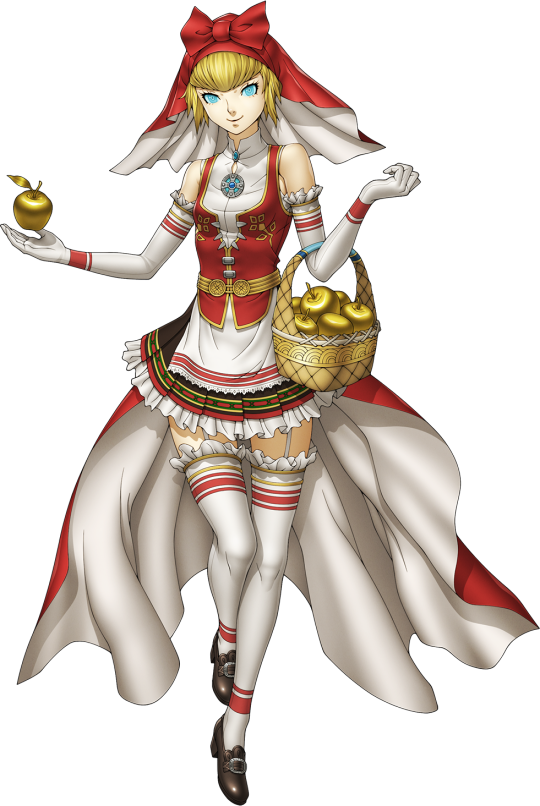
Norse mythology, as any amateur theologian would likely know, is a bizarre beast to look into- a winding complex of bastardized tales and Christian retcons that makes even some of its most iconic gods appear scantly and obscurely in its stories. However, our demon of the day is one of the most recurring goddesses in the entire pantheon- the goddess of apples and youth, Idun.
Well, maybe that's a bit of an overstatement, but a Norse god appearing in more stories than one in the Prose Edda is an accomplishment in-and-of-itself. Idun, also known as Idunn, Iduna, or Iðunn, is the ancient Norse deity who resides over apples, spring, youth, and rejuvenation- she was likely well worshipped in her place, representing such pleasant thoughts (outside of spring due to the scourge of pollen, but let's not get into that) and ideas. Her name even seems to be based upon ideas of kindness and healthiness, as it's based upon the old Norse words ið, meaning "again," and unna, meaning "to love."
All of this, alongside her association with one of the best fruits (objectively), apples, seems to paint her in the light of being a goddess that the common people looked up to and worshipped for a nice, peaceful life. Idun is also the wife of Bragi, the god of poetry, something that adds on to this lovingly creative persona- she seemed to have been a lesser goddess, yet one still revered and loved for her role in cultivating a beautiful year with fantastic food. Even today, in some pagan circles, she is still worshipped, as she was in the past as well, a goddess representing good spring and fortune.
Idun's most famous myth comes about with those same apples she treasures so dearly- they weren't any old apples, you see, as the ones she specifically grew were apples of immortality. These apples were relied upon by the pantheon to remain young and spritely (likely leading to her title as the goddess of youth given her role in cultivating those apples) and she protected the orchard where they were grown diligently. However, a jötunn by the name of Þjazi forced Loki's hand, getting him to drag Idun away from her orchard only to kidnap her. As a consequence of her absence, the gods soon began to grow old and frail, and finding nobody else responsible, they found the blame to be on the trickster god present.
The gods weren't mad with him specifically, though- they knew that Loki wasn't that petty and mean to steal the immortal apples without reason. As a result, in an effort to make him right his wrongs, they sent him out to retrieve Idun from the claws of the jötunn, Loki adopting the form of a falcon and chasing after the giant in great pursuit. After a while of searching, he found the (likely terrified, or maybe even annoyed) Idun, who turned into a single small nut to let him escape with her untouched. Shortly after Loki makes his daring escape, the giant comes back to find his captive goddess gone with the wind, and chases after Loki in hot pursuit in the form of a massive eagle. However, the gods devised a plan to stop this rampaging jötunn, causing the eagle to run right into a then-lit pyre and setting him ablaze. With Idun returned to them, they went back to eating from the immortal apple stock, and all lived happily ever after. Until Ragnarok stuff happens, but let's not worry about that!
While Idun does fill a role as an archetypal 'damsel in distress,' her main story does show how important she actually is to the Norse pantheon; without her, they wouldn't be able to live. As a result, while a minor deity, she has a major role in the pantheon- one that is reflected perfectly in her role in SMT V.
In SMT V, Idun's only current appearance, she appears as a late-game healer and support demon with a whole sidequest attached- one that I can't recant here due to not playing V, but it seems fun. Design-wise, she bears a striking resemblance to Little Red Riding Hood (as well as Aigis for some reason), something which feels obvious given her role as the owner of the divine orchard with a wicker basket holding her magical apples, drawing clear parallels with the apples that Red Riding Hood delivers to her grandma.
She also tends to hit the griddy.
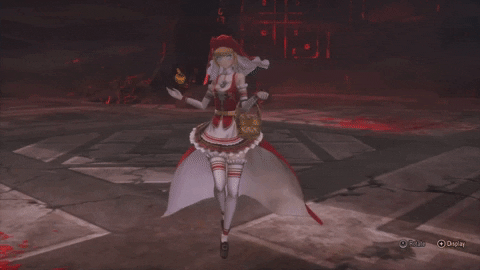
Why? Because it's cute!
Overall, this charmingly designed demon from one of the most famous mythologies out there gets an A in my book. The influence behind her design is clear, it's cute and effective, and it works given her folkloric prescedent.
17 notes
·
View notes
Text
Day 23 - Halphas
Race: Fallen
Alignment: Neutral-Chaos
April 22nd, 2024
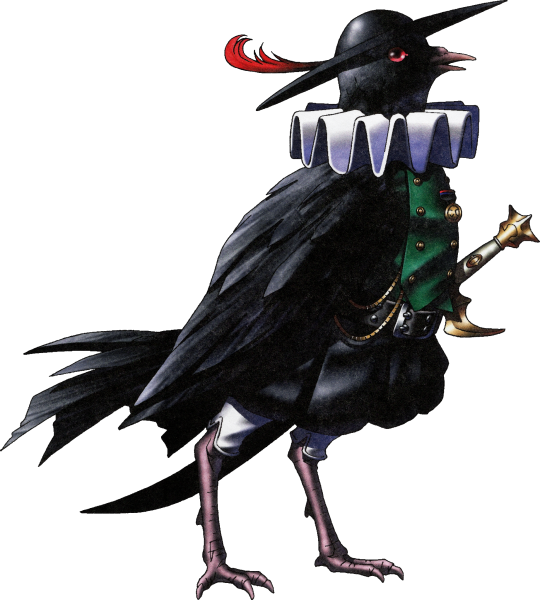
The Lesser Key of Solomon is a common source for demons throughout the SMT series, and for good reason- our favorite Goetic grimoire remains as the biggest still remaining demonic compendium out there, having 72 Marquis of hell to summon to assist in one's daily life. The demons of the Ars Goetia are varied and strange, but one sticks out as a personal favorite of mine- the regal Stock Dove, Halphas.
Listed as the 38th demon within the Ars Goetia, Halphas, also known as Malthus, is known as a "Great Earl," referred to as follows.
"The Thirty-eighth Spirit is Halphas, or Malthus (or Malthas). He is a Great Earl, and appeareth in the form of a Stock-Dove."
While, as with many goetic demons, the description of Halphas is vague, his reign seems to paint a picture of him being well versed in battle and blades, as his domain resides over the stocking of weaponry and sending people out to battle, almost like a tactician. He can also apparently build up towers, likely alluding to an ability to erect massive buildings from the ground in only an instant, owing to his immense demonic power- as a duke of hell, after all, his strength is nigh-unmatched. With a rule over 26 legions of spirits strong, the demonic warlord this bird turns out to be stands in quite interesting contrast to the typical representation of peace that a dove represents.
Design wise, the feathered cap and ruffled frills around the neck paint the image of this bird being some sort of great rich royalty, something supported by its reign as a Great Earl, and the gold blade he wields also gives way to the idea that this bird is a marquis of warfare. Overall a fantastic design filled with unique symbolism, and a personal favorite of mine.
#shin megami tensei#smt#megaten#persona#daily#halphas#malthus#malthas#the ars goetia#sorry for the short analysis! i've lost a bit of my steam lately#and the ars goetia demons dont have a lot to go into on their own.#i'll be back to regular soon tho!
11 notes
·
View notes
Text
Accidentally uploaded Day 24, which was a request, while in the drafts and very, very early in creation. Oops.
2 notes
·
View notes